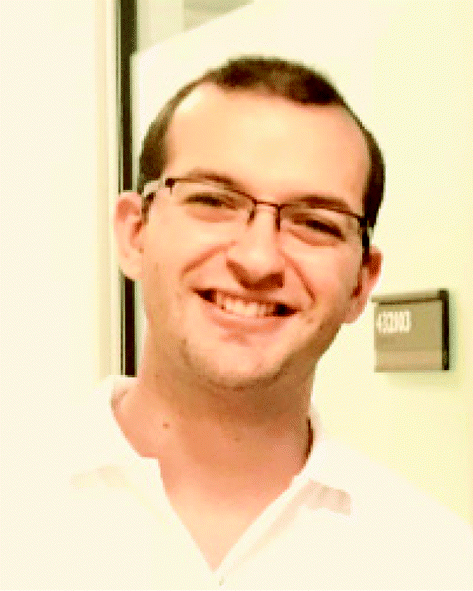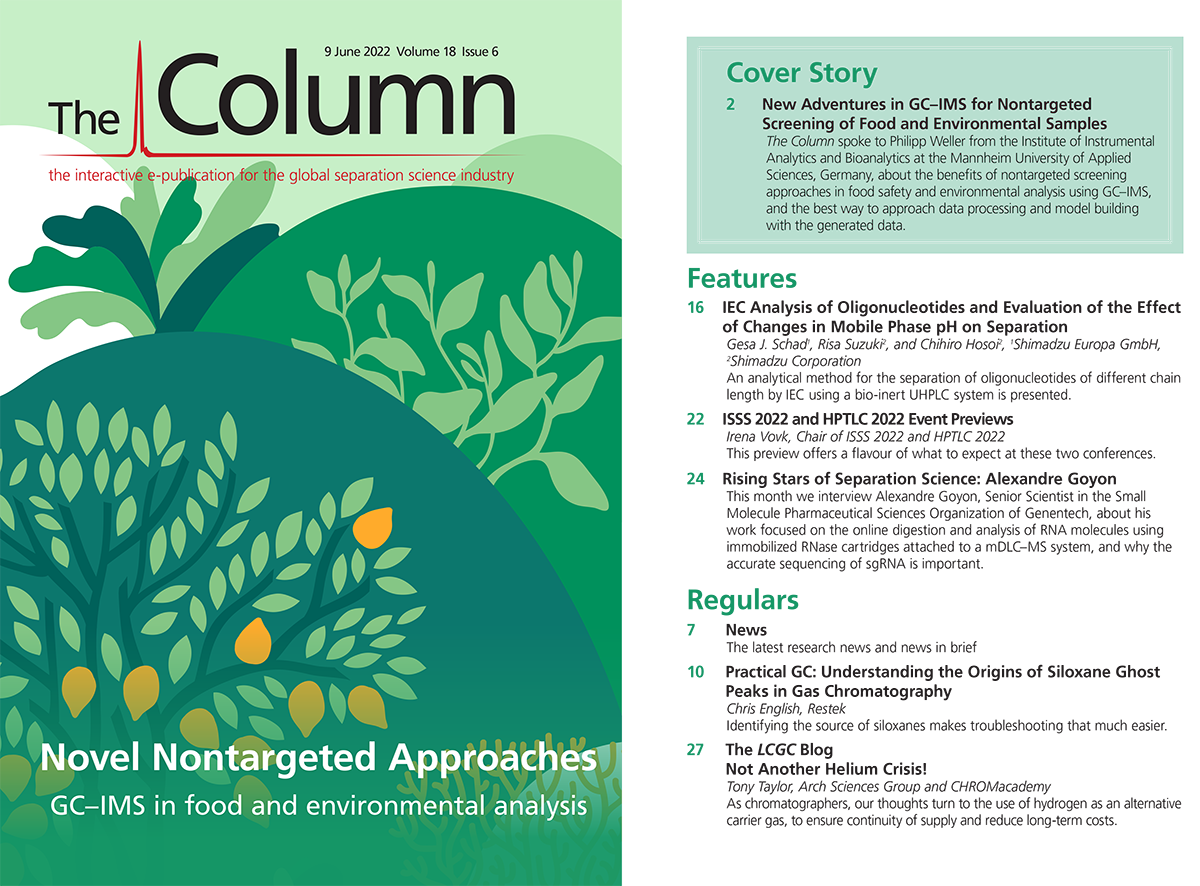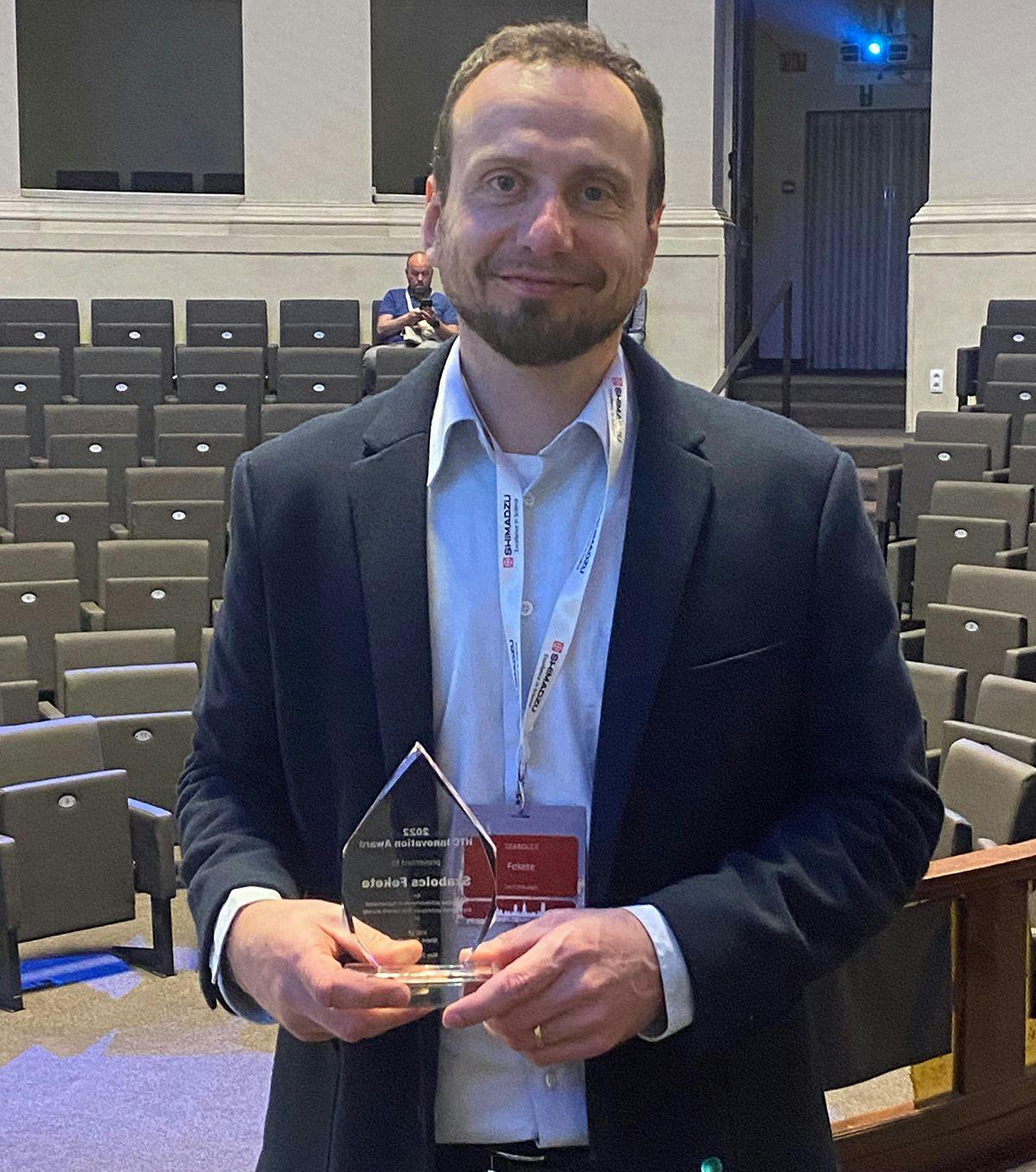Rising Stars of Separation Science: Alexandre Goyon
This month we interview Alexandre Goyon, Senior Scientist in the
Small Molecule Pharmaceutical Sciences Organization of Genentech, about his work focused on the online digestion and analysis of RNA molecules using immobilized RNase cartridges attached to a multidimensional liquid chromatography–mass spectrometry (mD‑LC–MS) system, and why the accurate sequencing of single guide RNA (sgRNA) is important.
Q. When did you first encounter chromatography and what attracted you to the subject?
A: My first experience with chromatography was during an internship in the laboratory of Professor Jessop (Kingston, Canada). The Jessop group is specialized in green chemistry. I analyzed samples using gas chromatography (GC) and liquid chromatography (LC) to conclude my experiments, and I knew that analytical chemistry was an area I would like to explore more. After completing my master’s degree, I joined the Nestle Research Center (Lausanne, Switzerland) where I developed LC–tandem mass spectrometry (MS/MS) methods to quantify food contaminants in various matrices.
Q. Can you tell us more about your Ph.D. thesis?
A: I performed my Ph.D. thesis at the University of Geneva under the supervision of Professor Jean-Luc Veuthey, Dr Davy Guillarme, and Dr Szabolcs Fekete. It was the first Ph.D. thesis in the laboratory dedicated to the analysis of therapeutic proteins. I have developed non-denaturing size-exclusion chromatography (SEC), cation-exchange chromatography (CEC),capillary zone electrophoresis (CZE), and hydrophobic interaction (HIC) methods to characterize monoclonal antibodies (mAbs) and antibody-drug conjugates (ADCs). I had unique opportunities to perform internships in pharmaceutical companies—Novartis (Basel, Switzerland) and Genentech (South San Francisco, USA)—where I developed innovative multidimensional (mD)-LC–MS methods to streamline existing analytical workflows and facilitate the characterization of complex drug modalities.
Q. What chromatographic techniques have you worked with?
A: I have worked with reversed-phase LC, hydrophilic interaction liquid chromatography (HILIC), SEC, CEC, anion exchange chromatography (AEC), HIC, and mixed mode chromatography (MMC) for the analysis of diverse molecules, including small pharmaceutical molecules, therapeutic antibodies, protein-polymer conjugates, oligonucleotides, and nucleic acids.
Q. You were involved in research that fully sequenced CRISPR/Cas9 single guide RNA (sgRNA) using parallel ribonuclease digestions and HILIC−high-resolution MS analysis (1). Why is accurate sequencing of sgRNA important?
A: With the CRISPR-Cas technique, a single guide RNA (sgRNA) directs the ribonucleoprotein (RNP) complex to a specific target. The CRISPR-Cas technique has attracted significant interest in the field of cell therapy. For example, T cells can be reengineered using this approach. It is crucial to verify the sequence of the sgRNA is correct to limit off-target effects and ensure the safety of the patients. Regulatory agencies expect investigational new drug (IND) applicants to sequence sgRNAs.
Q. What is novel about the method you developed? What were the main challenges from an analytical perspective and how did you overcome them?
A: A sequencing method should enable the verification of the correct nucleoside order. Ideally, the sequencing method should also confirm the presence and correct position of the chemical modifications, which is not feasible using next generation sequencing (NGS) approaches due to the loss of information during the library preparation.
To my knowledge, this parallel RNase digestion and HILIC–MS/MS approach was the first to confirm the correct order of the nucleosides and the presence of the chemical modifications. Ideally, the sequencing approach should provide 100% sequence coverage. However, the RNase digestion of 100-mer sgRNAs produces non-unique fragments, which reduces the sequence coverage. The challenge was overcome by using multiple RNases in parallel. Our approach required the development of robust i) digestion procedures, ii) chromatographic separation, and iii) MS detection. It was the first time that an RNase digestion mixture was analyzed by HILIC, which provided both truly MS-compatible conditions in the absence of ion-pairing agents and selectivity to discriminate sgRNA sequences. We found that RNase could contaminate HILIC columns and interfere with the analysis of RNase digestion mixtures.
Q. Is HILIC becoming more commonly used in biopharmaceutical research? If so, why, and in what areas?
A: In my experience, HILIC is becoming more and more utilized and in particular for the analysis of oligonucleotides. Advances in this field are fast, and I am confident future research works will unleash the potential of HILIC for the characterization of new drug modalities. The pharmaceutical landscape has become incredibly diverse, with the development of complex drug modalities beyond the Lipinski’s rule of five. In parallel, the coupling of MS instrument to LC separation has become essential to identify impurities. In many cases, HILIC is an ideal mode, preventing the use of ion-pairing agents needed for the reversed-phase LC analysis of polar molecules.
Q. You also recently published a paper presenting, for the first time, the online digestion and analysis of an RNA molecule using immobilized RNase cartridges attached to a two‑dimensional (2D)-LC–MS system and three-dimensional (3D)-LC–MS system (2). How did this project arise?
A: I am convinced that the automated digestion and analysis of large oligonucleotides offer unique benefits for their characterization. Bottom-up MS approaches enable i) the sequencing of large oligonucleotides, and ii) the identification/quantification of impurities at single residue level.
Conventional offline, in-solution digestions require a large amount of sample and intensive laboratory work, which may cause errors. Conversely, the automated digestion and analysis of large oligonucleotides via the use of immobilized RNase cartridge and HILIC analysis streamline the process. The advantage of an online procedure was even greater since three RNases were used for the parallel offline, in-solution digestions of sgRNAs.
A 3D-LC–MS approach enabling the online fractionation and bottom-up analysis of fractions was also developed to understand the cause of a peak tailing observed on the ion-pairing (IP) reversed-phase LC profiles of sgRNAs.
Q. What were your main findings and how does your approach benefit the analyst in practice?
A: The same sequence coverage was found using the online approach in comparison to the offline one. A 10-fold reduction in digestion time and 20-fold reduction in sample amount was achieved using the online 2D-LC–MS approach in comparison to the offline approach. Due to the limited amount of sgRNA available, the characterization of impurity peaks observed at the single nucleotide level could only be performed when using a 3D-LC method, enabling the automated fraction collection and digestion.
In practice, the analyst can save time and focus on other activities, such as data treatment, when using the online approach, since the digestion and analysis are automated.
Q. Is 2D-LC–MS becoming used more commonly for routine analysis in the pharma/biopharma sector? If so, in what application areas? Is 3D-LC likely to be used more widely?
A: In the field of pharmaceutical small molecules, 2D-LC–MS is used for the characterization of impurity peaks and/or screening of method conditions, such as mobile phases and LC columns. In the field of large molecules, 2D-LC–MS is also used for the desalting of fractions collected from one-dimensional (1D) analysis for the identification of impurities.
In addition, mD-LC–MS systems enable bottom-up MS characterization and fraction collection to be integrated. We have developed several of these methods to characterize fractions collected from reference purity methods—in the past for therapeutic antibodies and now for large oligonucleotides.
Q. Are chromatographers overcautious about implementing multidimensional methods?
A: Multidimensional methods may often sound complicated and only ever applied to specific projects. As a general rule, the simpler, the better. However, with the increasing complexity of drug modalities and delivery systems, some challenges cannot be solved using 1D-LC methods.
There is indeed an important challenge when going beyond two dimensions, which is mainly due to limited software solutions providing a user-friendly environment. The broader adoption of mD-LC–MS methods will depend on close collaboration between instrument vendors, pharmaceutical companies, and academic laboratories.
Q. What projects are you working on next?
A: I am hoping to see the implementation of mD-LC–MS methods to help understand manufacturing and purification processes. In particular, an ideal method would isolate pharmaceutical molecules from a biological matrix prior to their comprehensive impurity characterization. Such a streamlined method would provide multiple quality attributes, including titer and purity, and help guide the process.
References
- A. Goyon, B. Scott, K. Kurita, C.M. Crittenden, D. Shaw, A. Lin, P. Yehl, and K. Zhang, Anal. Chem. 93, 14792–14801 (2021).
- A. Goyon, B. Scott, K. Kurita, C. Maschinot, K. Meyer, P. Yehl, and K. Zhang, Anal. Chem. 94, 1169–1177 (2022).

Alexandre Goyon is Senior Scientist in the Small Molecule Pharmaceutical Sciences Organization of Genentech. He received a Ph.D. degree in pharmaceutical analytical chemistry in 2019 from the University of Geneva, Switzerland. His team supports early- andlate-stage research programs. They develop innovative multidimensional LC–MS methods and complementary approaches to support new drug modalities and drug delivery systems. He has published 36 papers and book chapters, including 23 as first author.

Common Challenges in Nitrosamine Analysis: An LCGC International Peer Exchange
April 15th 2025A recent roundtable discussion featuring Aloka Srinivasan of Raaha, Mayank Bhanti of the United States Pharmacopeia (USP), and Amber Burch of Purisys discussed the challenges surrounding nitrosamine analysis in pharmaceuticals.

.png&w=3840&q=75)

.png&w=3840&q=75)



.png&w=3840&q=75)



.png&w=3840&q=75)













